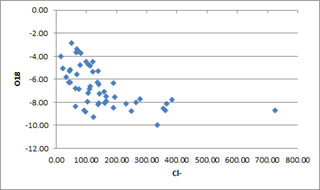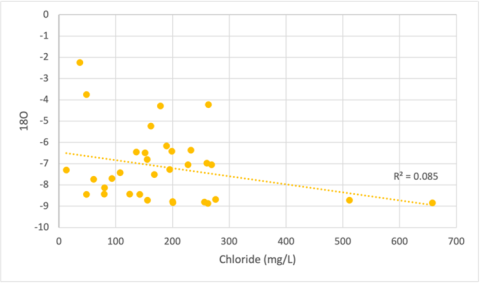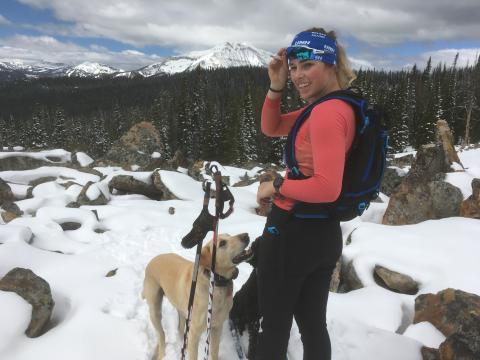In urban environments, aquatic ecosystems are an important source of water, recreation, and aesthetic value. Chloride is particularly damaging to these ecosystems, as high concentrations are toxic to fish and other organisms and can harm aquatic vegetation. This is especially a threat to urban aquatic ecosystems in northern climates where road salt is extensively applied during winter. This research, funded by a Summer Undergraduate Research Fellowship (SURF) from the Hamel Center for Undergraduate Research, focused on summer chloride concentrations in the Twin Cities Metro Area in Minnesota. Winter conditions and high road density in the Twin Cities mean that salt is heavily applied in the winter months, leading to high concentrations of chloride in its waterways. This project focused on what is less known: how chloride salt application in the winter translates to chloride concentrations in the more biologically productive summer months. The main objective was to use biogeochemical tracers and geospatial analysis to understand the factors that influence summer chloride concentration in urban aquatic ecosystems.
Methods
Along with my faculty mentor at the University of Minnesota and two undergraduates from the University of St. Thomas in Minnesota, I sampled thirty-six stream sites chosen to represent a diversity of representative stream types and locations across the Twin Cities area. All sites were thought to be at baseflow conditions, meaning low flow conditions in perennial streams that occur between precipitation events, at the time of sampling. Choosing the sites proved to be more difficult than I anticipated. Although sites were scouted on Google Maps ahead of time, upon arrival some sites could not be accessed safely or without crossing into private land. What’s more, despite the dry summer in Minneapolis the few storms that rolled through happened to coincide with sampling days, which meant I had to change the location or reschedule to ensure that samples were truly taken at baseflow conditions.
I used a Hach HQ40d conductivity probe to measure the conductivity and temperature of the water. The conductivity measurement gave a rough idea of the chloride concentration at each site. We collected a total of six samples at each site. Four samples were collected in polyethylene 20 mL scintillation vials by filtering water through 0.7m GF/F Whatman syringe filters, leaving headspace in the vial. These samples were designated for dissolved inorganic carbon (DIC) and ion analysis, with two replicates per analysis type. The other two samples, designated for water isotope analysis, were collected in glass 20 mL scintillation vials with cone-lined caps. These samples were not filtered, and no headspace was left in the vials. These three analyses primarily served to identify chloride concentrations and different compounds that serve as biogeochemical tracers to indicate whether groundwater or surface water dominated in each site. While all samples came from surface water streams, some streams are more dominated by inputs from the groundwater, meaning that water in those streams has remained in the system for a longer and may be chemically different from streams dominated by surface water, which reflect current inputs to the system. As summer groundwater is more likely to reflect those winter inputs of chloride, the tracers were intended to explain the variation in chloride concentrations between sites. Once we transported the samples back to the lab, the water isotope and DIC samples were refrigerated, and the ion samples were frozen.
A Thermo Scientific Integration High Pressure Ion Chromatography system was used to quantify chloride, fluoride, bromide, nitrate, nitrite, sulfate, and phosphate by ion chromatography. This analysis took place in the Research Analytical Laboratory at the University of Minnesota. The water isotope samples were analyzed for ratios of oxygen and hydrogen isotopes using a Picarro L-2130-i Isotope and Gas Concentration Analyzer. I measured DIC concentrations in the lab of Dr. Jacques Finlay at the University of Minnesota with a Shimadzu TOC-L.
For nineteen of the sites where watershed boundaries could be reliably defined, I used Model My Watershed (a website developed by Stroud Water Research Center) to determine watershed area and summarize land use within each watershed, and ArcGIS Pro to determine road density. I graphed chloride concentrations against the biogeochemical tracers, as well as the percentage of the watershed that was characterized as “developed” land use (excluding “open developed,” which included parks and golf courses), and road density per watershed area. I also compared chloride values amongst groundwater dominated and surface water dominated sites, and designated groundwater sites and non-spring sites (i.e., sites where there was an above-ground stream prior to the site location).

Figure 1. d18O values versus chloride concentrations from previous year’s data, provided by Dr. Jacques Finlay.
Results
Notably, at the time of sampling in summer 2023, the Minneapolis area had experienced an unusually high snow year, followed by a very dry summer, likely impacting the data. As a result, we did not observe much difference between groundwater and surface water dominated sites in terms of chloride concentration.
A dataset from a previous project and wetter summer conditions that focused on identifying nutrient sources showed that chloride can be reduced by summer rainfall. A plot of chloride concentration vs oxygen isotope values in the summers of 2012 and 2013 (Figure 1) showed higher chloride values in groundwater dominated sites compared to ones fed by runoff and lakes. The data I collected, on the other hand, shows moderate chloride concentrations appearing across both surface and groundwater sites (Figure 2).

Figure 2. d18O values versus chloride concentrations from summer 2023 collection period.
This heterogeneity among the data was unexpected, but given the unusual water year, a possible explanation is that heavy snow, while increasing the amount of road salt applied to roads, would also flush chloride out of the system with snowmelt. The dry spring and summer at the point of sampling could have limited the difference in chloride concentrations between surface water and groundwater dominated sites, as storm runoff was limited.
There was not much of a trend between chloride and DIC, which was unexpected and is likely also a reflection of the unusual water year. However, landcover analysis showed a positive relationship between chloride and the percentage of the watershed developed. Watershed road density had a positive logarithmic trend with chloride concentrations as well, indicating that land use and road density correspond to a significant increase in summer chloride concentrations in surface water, particularly in a dry summer such as this one.
Conclusion
These results help determine how winter road salt application interacts with snowmelt and hydrologic patterns to directly impact summer chloride concentrations in an urban aquatic ecosystem. This research also contributes to the Minneapolis-Saint Paul Long Term Ecological Research program (MSP-LTER) and will help improve the long-term monitoring of areas with high rates of winter road salt inputs to inform decisions and management of road salt application. I still have some analysis I would like to do, and I hope that this project can continue through the MSP-LTER project, if not within my own work, given the role that the unusual water year seemed to play in the results. I would certainly be interested in expanding this research to other locations to see how those results may vary as well. This project has greatly expanded my knowledge of the research process, and it will be the basis for my Honors thesis at UNH. I also plan to present this research at UNH's Undergraduate Research Conference in the spring.
I would like to thank Dr. Jacques Finlay for his help and guidance through this research project. I’m incredibly grateful for the support he gave me during every step of the research process and the time he dedicated. Thank you to everyone in the Finlay lab, particularly Grace Neumiller for her help with this project, and thank you to Megan West and Joey Bergeron for assisting me with the field days. I would like to thank Dr. Wilfred Wollheim for his support as well. Lastly, thank you to the Hamel Center for Undergraduate Research for providing me with this incredible research opportunity, and Mr. Dana Hamel and Dr. Erika Washburn for the funding that allowed me to pursue this research project.
Author and Mentor Bios

Georgianna Fischer, of Bozeman, Montana, will graduate in the spring of 2024 with a bachelor of science degree in environmental science with an ecosystems concentration and a geospatial analysis minor. Georgianna is a member of the University Honors Program, pursuing honors in major, and is a member of Chi Alpha Sigma, the college athlete honor society, as part of the Nordic ski team. Georgianna has been interested in doing research in environmental science since she was a kid, and always knew she wanted to do a research project during her undergraduate career. When she learned that the Summer Undergraduate Research Fellowship (SURF) program could be used for research outside of Durham, she jumped at the opportunity. After consulting with her advisor about who would be able to mentor aquatic research in Minneapolis, she was connected to Dr. Finlay at the University of Minnesota. During her research, she learned about urban ecosystems and how research works in a very urban environment. Georgianna also found it satisfying to put together a dataset that she collected herself and knows exactly what each point represents. After finishing her undergraduate degree, she plans to pursue a career in environmental science and geospatial analysis. Her research experience made her realize she enjoys the research process, and it could be a viable career option.
In understanding the environment as an integrated system, Wilfred Wollheim’s Water Systems Analysis Group explores the physical, chemical and biological processes that shape hydrological systems, with emphasis on the unique role of humans as agents of change. The lab’s research and educational programs cross the boundaries of traditional scientific disciplines to foster interdisciplinary understanding of environmental change. Through field monitoring, whole ecosystem experiments, novel in situ sensor deployments, and dynamic hydrological and ecosystem modeling, researchers attempt to understand hydrological and biogeochemical dynamics at scales ranging from individual ecosystems to whole river systems to the global systems of inland waters. Built on strong collaborations that are national and international in scope, the group also serves as a teaching platform for the next generation of ecosystem and earth system scientists. Wollheim is a professor in the Department of Natural Resources and the Environment at the University of New Hampshire.
Jacques Finlay grew up in New Hampshire, received his bachelor of science degree from University of New Hampshire in 1990, and stayed on as research staff for several years before heading to graduate school. Since 2003, he has been a professor in the Department of Ecology, Evolution and Behavior at the University of Minnesota (UMN). Dr. Finlay’s lab at UMN explores the workings of freshwater ecosystems, and how watersheds, organisms and human activities alter their biogeochemistry, ecology and services. He also teaches courses in freshwater science. He says that one of the best parts of his job is working with undergraduates like Georgi. In doing so, he learned a lot about a topic that he’s been wanting to dig in to (the behavior of road salt in diverse urban waterways). The project was more complicated than expected because of the extreme drought following winter, which showed that climate patterns affect the movement of pollutants in urban areas. Dr. Finlay is excited to continue to work with Georgi and the lab’s team on this research as they head into another winter in Minnesota.
Copyright © Georgianna Fischer
